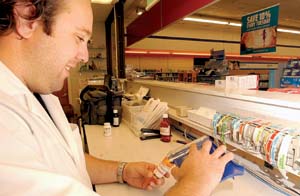Following your doctor’s orders is one thing, understanding them
can be quite another.
Especially if you’re one of the 90 million adults with
”
limited health literacy,
”
who have trouble understanding the directions listed on
medications or instructions from their doctor.
Following your doctor’s orders is one thing, understanding them can be quite another.
Especially if you’re one of the 90 million adults with “limited health literacy,” who have trouble understanding the directions listed on medications or instructions from their doctor. The biggest problems occur in those who speak little or no English and struggle to follow instructions they can’t even read, according to a report released Thursday by the Institute of Medicine.
With a Hispanic population of more than 50 percent in San Benito County, employing plenty of Spanish-speaking personnel who encourage interaction within the county’s health facilities is imperative, Physician’s Assistant Herman Nava said.
“We’re in an area where we have a lot of immigrants. Some cultures look at doctors as ‘up here’ and not to question them,” Nava said. “So they don’t ask the questions they should ask.”
Nava, who is the primary care provider at the Hazel Hawkins Community Healthcare Clinic in San Juan Bautista, sees many patients come in who are ignorant to why they’re taking certain medications, or what past physicians have diagnosed them with, he said.
“Doctors come in and blow out words and the patients don’t know what they said,” he said. “Physicians are taught to speak a foreign language. We can talk amongst ourselves, but until you’re a patient you can’t appreciate that (language barrier).”
Spouting complicated medical terms can intimidate even a highly educated individual. Often times people are ashamed that they don’t understand what the doctor is saying and if they ask questions the physician will think they’re dumb, the report stated. However, Nava said taking more time to educate patients and explain in a straightforward way what their symptoms are before sending them off with a prescription is a way to combat this frightening trend.
“It’s like in school,” Nava said. “The only dumb question is the one you don’t ask.”
Much of the medical literature and information that attempts to educate and inform the public concerning health issues or prescription directions are too complex for many people to understand, according to the report.
It sited an example of a mother pouring an oral antibiotic into her child’s infected ear because the prescription didn’t say to swallow the liquid.
A degeneration in the medical care system, where doctors are taught to treat diseases and not people, and to push drugs instead of insight is much to blame for this problem, said Muree Reafs, director of nursing at the San Benito County Public Health Department.
“We are not a society interested in the well-being of our fellow man, or so it seems at this time,” Reafs said. “Doctors are trying to provide care within a structure that’s so distorted… Very few physicians actually sit down and take a good history, and then listen to that history.”
Reafs has seen first-hand the confusion felt by people who are attempting to administer drugs to themselves or their families without any understanding of what they’re taking or why, she said.
Many times convoluted medical terminology is used by lawyers to protect institutions and companies from liability, she said.
“They make it unreadable so people don’t read it,” she said.
This low health literacy not only compromises patients’ health, but inflates medical costs across the board, the report said.
Patients being hospitalized and using emergency services more is a direct effect of health ignorance.
Taking the time to explain the side effects of a certain prescription could mean a major difference monetarily, Nava said.
“People end up in the ER for no apparent reasons,” he said. “If a provider had taken a couple more minutes to educate them it could prevent it… But many times in order to make a decent living physicians have to cut corners, and what better way than time?”
Health literacy is nothing new, but the effects of it are becoming more and more apparent in our product-driven, consumer-pleasing society, Reafs said.
“Doctors are now being taught to meet the constant demand,” she said. “And the constant demand is based on ignorance.”










